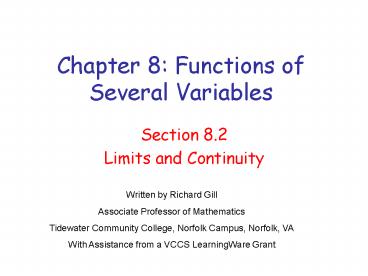Chapter 8: Functions of Several Variables PowerPoint PPT Presentation
1 / 12
Title: Chapter 8: Functions of Several Variables
1
Chapter 8 Functions of Several Variables
- Section 8.2
- Limits and Continuity
Written by Richard Gill Associate Professor of
Mathematics Tidewater Community College, Norfolk
Campus, Norfolk, VA With Assistance from a VCCS
LearningWare Grant
2
This section will extend the properties of limits
and continuity from the familiar function of one
variable to the new territory of functions of two
or three variables.
I hate to bring up painful memories but here is
the formal definition of a limit back when we
were dealing with functions of one variable.
In less formal language this means that, if the
limit holds, then f(x) gets closer and closer to
L as x gets closer and closer to c.
3
Just to refresh your memory, consider the
following limits.
Good job if you saw this as limit does not
exist indicating a vertical asymptote at x -2.
This limit is indeterminate. With some algebraic
manipulation, the zero factors could cancel and
reveal a real number as a limit. In this case,
factoring leads to
The limit exists as x approaches 2 even though
the function does not exist. In the first case,
zero in the denominator led to a vertical
asymptote in the second case the zeros cancelled
out and the limit reveals a hole in the graph at
(2, ¼).
4
The concept of limits in two dimensions can now
be extended to functions of two variables. The
function below uses all points on the xy-plane as
its domain.
If the point (2,0) is the input, then 7 is the
output generating the point (2,0,7).
If the point (-1,3) is the input, then 13 is the
output generating (-1,3,13).
For the limit of this function to exist at
(-1,3), values of z must get closer to 13 as
points (x,y) on the xy-plane get closer and
closer to (-1,3). Observe the values in the table
to see if it looks like the limit will hold.
5
The concept of limits in two dimensions can now
be extended to functions of two variables. The
function below uses all points on the xy-plane as
its domain.
For the limit of this function to exist at
(-1,3), values of z must get closer to 13 as
points (x,y) on the xy-plane get closer and
closer to (-1,3). Observe the values in the table
to see if it looks like the limit will hold.
The table presents evidence that the limit will
hold, but not proof. For proof we have to go back
to epsilon and delta.
6
Definition of a Limit
7
Definition of Continuity of a Function of Two
Variables
A function of two variables is continuous at a
point (a,b) in an open region R if f(a,b) is
equal to the limit of f(x,y) as (x,y) approaches
(a,b). In limit notation
The function f is continuous in the open region R
if f is continuous at every point in R.
The following results are presented without
proof. As was the case in functions of one
variable, continuity is user friendly. In other
words, if k is a real number and f and g are
continuous functions at (a,b) then the functions
below are also continuous at (a,b)
8
The conclusions in the previous slide indicate
that arithmetic combinations of continuous
functions are also continuousthat polynomial and
rational functions are continuous on their
domains.
Finally, the following theorem asserts that the
composition of continuous functions are also
continuous.
9
Example 1. Find the limit and discuss the
continuity of the function.
Solution
The function will be continuous when 2xy gt 0.
Example 2. Find the limit and discuss the
continuity of the function.
Solution
10
Example 3. Use your calculator to fill in the
values of the table below. The first table
approaches (0,0) along the line yx. The second
table approaches (0,0) along the line x0. (If
different paths generate different limits, the
official limit does not exist.) Use the patterns
to determine the limit and discuss the continuity
of the function.
-1.04
-0.69
-0.35
0
0.35
0.69
1.96
2.30
4.26
4.61
Calculate these values yourself. Then click to
confirm.
11
Solution from the graph, it appears that z
values get larger and larger as (x,y) approaches
(0,0). Conceptually, we would expect values of
the natural log function to approach infinity as
the inputs approach 0. The numeric values in the
table appear to agree. The conclusion
12
This is the end of lesson 8.2. There will be
three sets of exercises available for this
lesson. Each lesson will have 6 exercises. Print
the exercises first and work out the answers.
When you submit the answers on Blackboard, each
exercise worked correctly will add to your
thinkwell exercise total.

